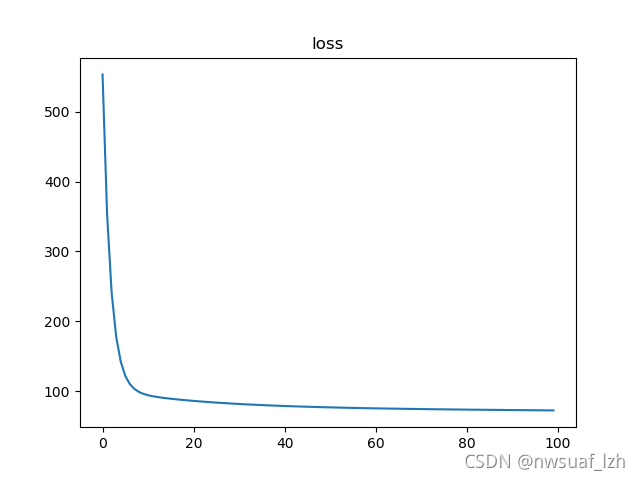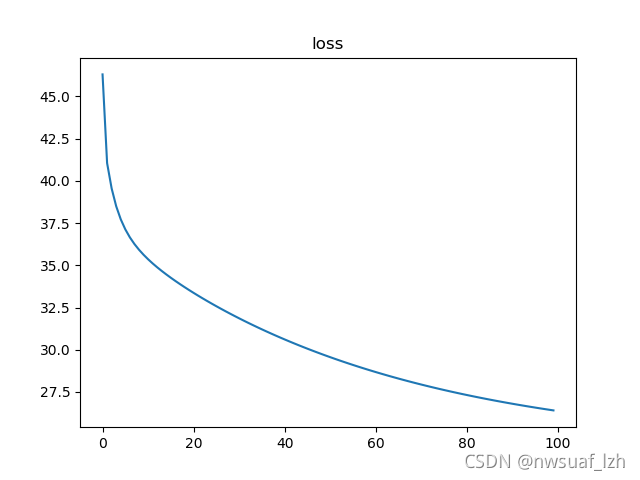多元线性回归,数据集为boston房价与周边环境等因素,以下为代码
#2021.10.13 HIT ATCI LZH
#多元线性回归,数据集为boston房价与周边环境等因素,参照网上的例子
import tensorflow as tf
from tensorflow.python.ops import init_ops
from tensorflow.python.training import optimizer
import numpy as np
import matplotlib.pyplot as plt
#加载boston房价数据集
boston = tf.contrib.learn.datasets.load_dataset('boston')
X_train, Y_train = boston.data, boston.target
#对数据集的格式进行解析
print('数据加载成功!')
print('boston.type is',type(boston))
print('X_train.type =', type(X_train))
print('X_train.ndim =',X_train.ndim)
print('X_train.shape =',X_train.shape)
print('X_train.dtype =',X_train.dtype)
print('X_train 的行数 m = {0}, 列数 n = {1}'.format(X_train.shape[0],X_train.shape[1]))
print('Y_train.type =', type(Y_train))
print('Y_train.ndim =',Y_train.ndim)
print('Y_train.shape =',Y_train.shape)
print('Y_train 的行数 m = {0}, 列数 n = None'.format(Y_train.shape[0]))
print('Y_train.dtype =',Y_train.dtype)
#因为各特征的数据范围不同,需要归一化特征数据
#定义归一化函数
def normalize(X):
mean = np.mean(X) #均值
std = np.std(X) #默认计算每一列的标准差
X = (X - mean)/std
return X
#定义一个额外的固定输入权重与偏置结合起来,该技巧可以有效的简化编程
def append_bias_reshape(features, labels):
m = features.shape[0] #行数
n = features.shape[1] #列数
x = np.reshape(np.c_[np.ones(m), features],[m, n+1])
y = np.reshape(labels, [m, 1]) #将lables由向量变为矩阵
return x,y
X_train = normalize(X_train) #对输入变量按列进行归一化
X_train, Y_train = append_bias_reshape(X_train, Y_train) #对X_train进行处理,增加一列全1向量,处理后只有矩阵相乘,可以省略掉偏置相加的过程
m = len(X_train) #训练集样本数量
n = X_train.shape[1] #number of features + biases
print(n)
#对归一化的效果进行查看
#为训练数据申明Tensorflow占位符
X = tf.placeholder(tf.float32,shape = [m , n], name='X') #每次训练全部导入数据,bitchsize就是全部数据集,因此shape = [m , n]
Y = tf.placeholder(tf.float32, name='Y')
#创建Tensorflow的权重和偏置且初始值设为0
w = tf.Variable(tf.random_normal([n, 1]))
#由于定义了函数append_bias_reshape, 因此不需要b = tf.Variable(0.0)
#b = tf.Variable(0.0)
#定义用于预测的线性回归模型
Y_hat = tf.matmul(X, w)
#定义损失函数
loss = tf.reduce_mean(tf.square(Y - Y_hat))#损失函数,均方误差
#选择梯度下降优化器,并设置学习率
optimizer = tf.train.GradientDescentOptimizer(learning_rate=0.01).minimize(loss) #学习率
#申明初始化操作符
init_op = tf.global_variables_initializer()
total = []#定义一个空列表
#启动计算图
with tf.Session() as sess:
sess.run(init_op)#初始化变量
for i in range(100):
_, l = sess.run([optimizer, loss],feed_dict = {X:X_train, Y:Y_train})
total.append(l)
print('Epoch {0}: Loss {1}'.format(i, l))
w_value = sess.run(w)
#print(b_value)
#print(w_value)
#绘制损失函数
plt.figure(num=1)
plt.title('loss')
plt.plot(total)
plt.show()

由上图我们可以发现,当Epoch大于20之后,loss的变化趋于平缓,这说明训练次数并非越多越好。
2、还有一种编程思路是挨个儿把数据放到feed_dict中去 ,可以用zip函数进行遍历
#2021.10.13 HIT ATCI LZH
#多元线性回归,数据集为boston房价与周边环境等因素,参照网上的例子
import tensorflow as tf
from tensorflow.python.ops import init_ops
from tensorflow.python.training import optimizer
import numpy as np
import matplotlib.pyplot as plt
#加载boston房价数据集
boston = tf.contrib.learn.datasets.load_dataset('boston')
X_train, Y_train = boston.data, boston.target
#对数据集的格式进行解析
print('数据加载成功!')
print('boston.type is',type(boston))
print('X_train.type =', type(X_train))
print('X_train.ndim =',X_train.ndim)
print('X_train.shape =',X_train.shape)
print('X_train.dtype =',X_train.dtype)
print('X_train 的行数 m = {0}, 列数 n = {1}'.format(X_train.shape[0],X_train.shape[1]))
print('Y_train.type =', type(Y_train))
print('Y_train.ndim =',Y_train.ndim)
print('Y_train.shape =',Y_train.shape)
print('Y_train 的行数 m = {0}, 列数 n = None'.format(Y_train.shape[0]))
print('Y_train.dtype =',Y_train.dtype)
#因为各特征的数据范围不同,需要归一化特征数据
#定义归一化函数
def normalize(X):
mean = np.mean(X) #均值
std = np.std(X) #默认计算每一列的标准差
X = (X - mean)/std
return X
#定义一个额外的固定输入权重与偏置结合起来,该技巧可以有效的简化编程
def append_bias_reshape(features, labels):
m = features.shape[0] #行数
n = features.shape[1] #列数
x = np.reshape(np.c_[np.ones(m), features],[m, n+1])
y = np.reshape(labels, [m, 1]) #将lables由向量变为矩阵
return x,y
X_train = normalize(X_train) #对输入变量按列进行归一化
X_train, Y_train = append_bias_reshape(X_train, Y_train) #对X_train进行处理,增加一列全1向量,处理后只有矩阵相乘,可以省略掉偏置相加的过程
m = len(X_train) #训练集样本数量
n = X_train.shape[1] #number of features + biases
print(n)
#对归一化的效果进行查看
#为训练数据申明Tensorflow占位符
X = tf.placeholder(tf.float32,shape = [None , n], name='X') #每次训练
Y = tf.placeholder(tf.float32, name='Y')
#创建Tensorflow的权重和偏置且初始值设为0
w = tf.Variable(tf.random_normal([n, 1]))
#由于定义了函数append_bias_reshape, 因此不需要b = tf.Variable(0.0)
#b = tf.Variable(0.0)
#定义用于预测的线性回归模型
Y_hat = tf.matmul(X, w)
#定义损失函数
loss = tf.reduce_mean(tf.square(Y - Y_hat))#损失函数,均方误差
#选择梯度下降优化器,并设置学习率
optimizer = tf.train.GradientDescentOptimizer(learning_rate=0.01).minimize(loss) #学习率
#申明初始化操作符
init_op = tf.global_variables_initializer()
total = []#定义一个空列表
#启动计算图
with tf.Session() as sess:
sess.run(init_op)#初始化变量
for i in range(100):
epoch_loss = 0. #存储每导入一个数据的loss
#_, l = sess.run([optimizer, loss],feed_dict = {X:X_train, Y:Y_train})
for x,y in zip(X_train,Y_train):
_, l = sess.run([optimizer, loss],feed_dict = {X:x.reshape([1,14]), Y:y}) #每feed进去一组数据便进行一次参数的训练
epoch_loss += l
total.append(epoch_loss/m)
print('Epoch {0}: Loss {1}'.format(i, l))
w_value = sess.run(w)
#print(b_value)
#print(w_value)
#绘制损失函数
plt.figure(num=1)
plt.title('loss')
plt.plot(total)
plt.show()

两种方法对比可以发现,第二种的loss在前几次的Epoch已经是非常小的,且每次Epoch都有明显的提升。








 本文通过TensorFlow展示了如何使用两种不同的方法实现多元线性回归,数据集为波士顿房价数据。第一种方法是一次性喂入全部训练数据,第二种方法是逐个样本进行训练。实验结果显示,第二种方法在较早的迭代次数中就达到了较低的损失值,并且每次迭代都有明显提升。这表明,对于小规模数据,逐样本训练可能更为有效。
本文通过TensorFlow展示了如何使用两种不同的方法实现多元线性回归,数据集为波士顿房价数据。第一种方法是一次性喂入全部训练数据,第二种方法是逐个样本进行训练。实验结果显示,第二种方法在较早的迭代次数中就达到了较低的损失值,并且每次迭代都有明显提升。这表明,对于小规模数据,逐样本训练可能更为有效。

















 2万+
2万+

 被折叠的 条评论
为什么被折叠?
被折叠的 条评论
为什么被折叠?










